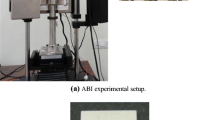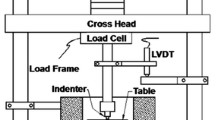Abstract
Temperature dependence of ball indentation behaviour of Armox500T and IN718 in terms of Meyer’s hardness, constraint factor (CF) and pile-up around indentation as a function of average strain at ambient temperature and elevated temperature (673 K) has been analysed using FEA. Subsequently, FE model has been validated by experimental data for IN718 and Armox500T. The value of CF for Armox500T and IN718 at RT is found to be 2.80 and 2.75, respectively. The CF value is increased to 3.66 and 3.41, respectively, at 673 K indicating the dependence of temperature. It is also observed that pile-up at a given strain for Armox500T is higher (low strain hardening) compared to IN718 (high strain hardening) under static indentation conditions. The FEA results are in good agreement with expansion cavity model and fully plastic model.








Similar content being viewed by others
References
Johnson K L, Contact Mechanics, Cambridge University Press, Cambridge (1987).
Lee C H, Masaki S, and Kobayashi S, Int J Mech Sci 14 (1972) 417IN1421.
Tabor D, The Hardness of Metals, Oxford University Press, Oxford (2000).
Francis H A, J Eng Mater Technol Trans ASME 98 (1976) 272.
Tirupataiah Y, and Sundararajan G, Process Mater Sci Eng 91 (1987) 169.
Tirupataiah Y, and Sundararajan G, Metall Trans A 22 (1991) 2375.
Moteff J, Bhargava R K, and Mccullough W L, Metall Trans A 6 (1975) 6.
Patnaik M N M, Narasimhan R, and Ramamurty U, Acta Mater 52 (2004) 3335.
Tirupataiah Y, and Sundararajan G, J Mech Phys Solids 39 (1991) 243.
Xu Z, and Huang F, Acta Mech Solida Sin 25 (2012) 598.
Kumaraswamy A, and Rao V V, Mater Sci Eng A 527 (2010) 6230.
Saxena A, Kumaraswamy A, Sethi S, Reddy G M, and Madhu V, J Mater Eng Perform. https://doi.org/10.1007/s11665-018-3487-3.
Johnson K L, J Mech Phys Solids 18 (1970) 115.
Richmond O, Int J Mech Sci 16 (1974) 75.
Barényi I, Híreš O, and Lipták P, Problemy Mechatroniki: uzbrojenie, lotnictwo, inżynieriabezpieczeństwa 4 (2013) 7.
Kumaraswamy A, and Venkataraman B, Scr Mater 54 (2006) 493.
Li W, Zeng F, Chen G, Deng Y, Liu G, Zhang X, Bezold A, and Broeckmann C, Int J Press Vessels Pip 162 (2018) 11.
Saxena A, Rai A, and Kumaraswamy A, Trans Indian Inst Met 70 (2017) 1549.
Sundararajan G, and Tirupataiah Y, Bull Mater Sci 17 (1994) 747.
Acknowledgements
The authors are grateful to Vice Chancellor, DIAT (DU), Pune for permitting him to publish this paper in the journal. The authors are also thankful to Director, DMRL, Hyderabad for extending the facilities for conducting a number of experiments. Acknowledgements are also due to the scientists and technical staff from Armor division, DMRL, Hyderabad.
Author information
Authors and Affiliations
Corresponding author
Rights and permissions
About this article
Cite this article
Saxena, A., Kumaraswamy, A. Numerical Analysis of Effect of Temperature on Ball Indentation Behaviour of Armox500T and IN718. Trans Indian Inst Met 71, 3111–3116 (2018). https://doi.org/10.1007/s12666-018-1508-4
Received:
Accepted:
Published:
Issue Date:
DOI: https://doi.org/10.1007/s12666-018-1508-4




